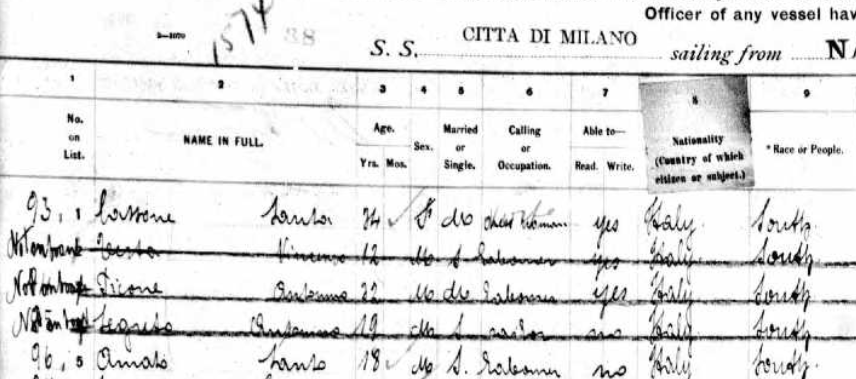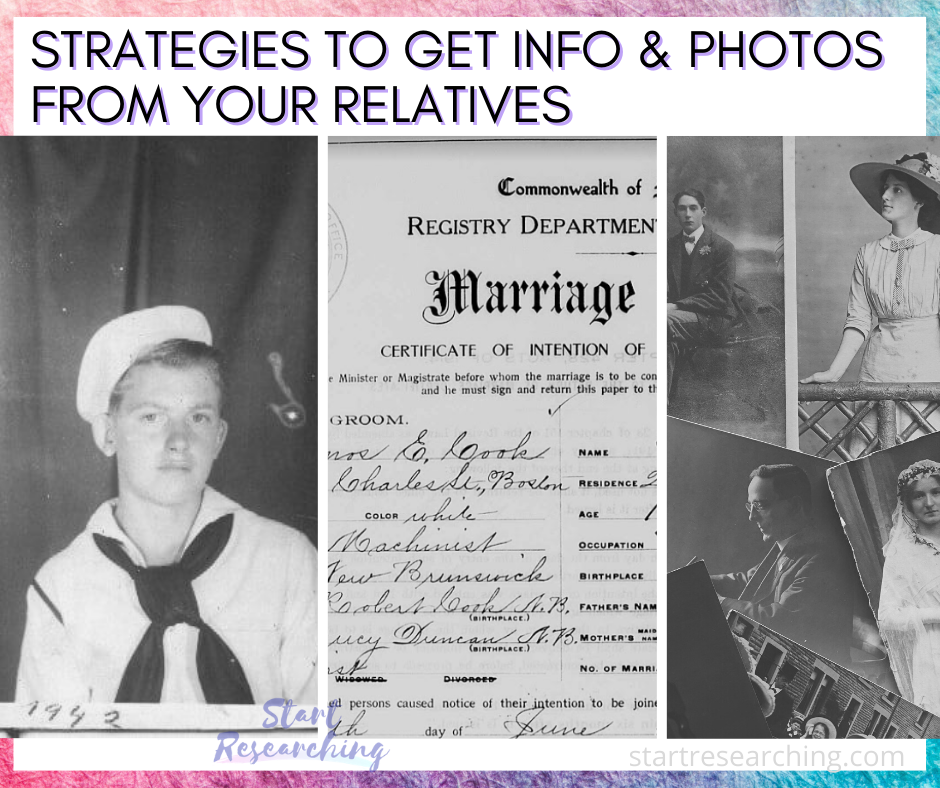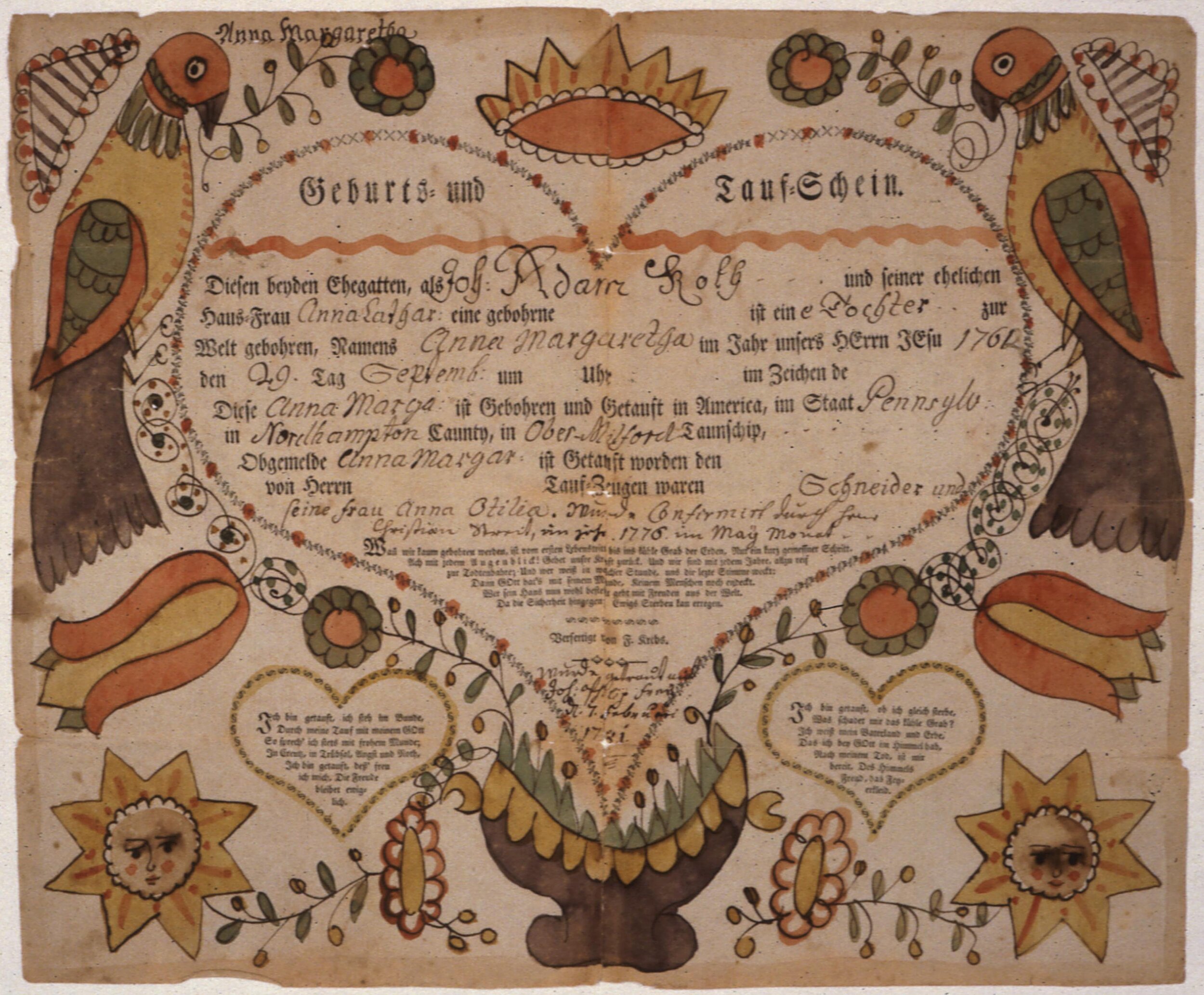When you look at a list of passengers arriving at a port in the U.S., you’ll see the names of those traveling on the ship, as well as their ages, the port and country they departed from, and perhaps their place of birth. It might show how much money they arrived with in their pockets. They may have given a name and address of their connection in the country (which weren’t always factual), if they are able to read and write in English, their race, if they are married or single, their occupation, and their intended destination. That’s a lot of valuable information for a genealogist.
However, if you’re not taking a look at the notations, abbreviations, and marks on the page you might be missing even more. Perhaps the person listed on the manifest never even made it on board the ship!
In this post we’ll go over some of the more prolific abbreviations and markings, including:
Ditto or Quotation Marks
USB (U.S. Born) or USC (U.S. Citizen)
S.I. (Special Inquiry) and “X” and Several Reasons for Being Held (Husb., Bro, LPC, Under 16, Tel, Tel $, Med, DCD, LCD, No Boat)
Line Through Names
Not on the Ship (DNS or Did Not Sail; NOB or Not On Board; NS or Not Shipped)
Naturalization Numbers
DEP
While there were some discrepancies between ports and variations between years, you should be able to determine the meaning behind the markings in this post. You should also check out “A Guide to Interpreting Passenger List Annotations” by Marian Smith, available on JewishGen.org, for a more in-depth, qualified analysis of these and other notations and markings. Marian L. Smith, though recently retired, was the senior historian at U.S. Citizenship and Immigration Services (USCIS), previously Immigration and Naturalization Service (INS), having joined the later in 1988 as their first historian (SHFG.org).
Ditto or Quotation Marks
Let’s start with an easy one that you’ve likely come across before in your work - things that mean “ditto” or “same as above”. This could be a quotation mark (or typed as _”_ or double quotation marks, ), the word “ditto”, or ditto abbreviated as “do”, or another letter or symbol (like the letter “V”). In the image below, what do you see?
In this early passenger list, you’ll see quotation marks meaning “ditto” or same as listed above, in the Name column, the Sex, Country to which they severally belong, and Country of which they intend to become inhabitants. Note while there is empty space in the Occupation column, there is no mark - so only the first passenger, Patrick, is a confirmed Blacksmith... Ancestry.com, Massachusetts, U.S. Arriving Passenger and Crew Lists. 1833, Oct, All Arrivals. [Database-on-line] Provo, UT. Ancestry.com Operations, Inc., 2006.
In many pages, you’ll note multiple forms of this. You may see quotation marks used in one column, and “ditto” or “do” in another for example.
In the left column it says “U.S. born” and underneath the abbreviation “do” for “ditto” is written three times. Would you have noticed all of the Di Lorenzo children where born in the U.S. looking at this? There are also quotation marks meaning same as above / child in the far right column... Ancestry.com, New York, U.S., Arriving Passenger and Crew Lists (including Castle Garden and Ellis Island), 1820-1957. Year: 1905; Arrival: New York, New York, USA; Microfilm Serial: T715, 1897-1957; Line: 1, Page Number: 41.[Database-on-line] Provo, UT. Ancestry.com Operations, Inc., 2010.
U.S.B. or U.S.C
In addition to “U.S. Born” (shown in image above) you may see “U.S.B.”. Also “U.S.C” for United States Citizen (See Smith’s section on “Annotations Regarding Nationality and Citizenship”).
Special Inquiry or “X”
A Special Inquiry meant cause for further examination, usually in the form of more interviews by officials or doctors. May show as the initials “S.I.” or “B.S.I.” for Board of Special Inquiry. May be a stamp of “Admitted” or “Deported” on or above the initials. Appears in the left column before the name.
Note on the left hand side, the initials “S.I.” with the word “admitted” stamped on them. FamilySearch.org, New York, New York Passenger and Crew Lists, 1909; 1925-1957. Vol 8222-8224 Jan 5, 1925. Image 25.
While Special Inquiry means they were sent for a hearing or trial, an “X” in the far left column usually means they were just detained for a brief while (See further below: Husb, Bro, Tel, Tel $, or No Boat). Instead of an “X” you may see a “D” for “Detained” but depending on the port, those detained might also be subjected to a hearing.
Several reasons an alien would be held for Special Inquiry or Detained:
Women (or children) waiting for someone to meet them. You may see “Husb” or “Bro” indicating their husband or brother was on their way to pick them up, as women were generally not allowed to travel alone. These passengers were likely detained for a short time.
“LPC” or Likely Public Charge, or those likely to become a burden to tax payers. Many reasons for LPC like being a single woman, not having enough money, or having a medical condition. Could be grounds for deportation.
Similarly “Under 16” was indicative of minor children not traveling to reunite with a parent.
“Tel” or “Tel $” meaning Telegram, meaning they didn’t have sufficient funds to travel to their intended destination, and they sent a telegram requesting money from a relative or someone else.
“MED” or medical reasons. These people may have been sent to hospitals or local medical buildings (some ports like Ellis Island had their own) or in some cases deported. You may also see D.C.D or L.C.D. for Loathsome or Dangerous Contagious Disease.
“No boat”, meaning a smaller boat wasn’t available to take them to shore or the dock just yet, and they had to wait.
“STOW”, a stowaway, usually deported.
This list above is not complete. For example, an immigrant may have been rejected for being a criminal or anarchist. Explore more reasons on Smith’s “Causes (Grounds) for Exclusion Noted on BSI Lists, ca. 1903-1924”.
In New York passenger lists, you may see a separate form (“Record of Aliens Held for Special Inquiry”) that may explain the charge for special inquiry, note the meals served (which can give you an idea how long they stayed if it doesn’t say elsewhere), and the resolution of the inquiry. These forms began in 1903 (Smith).
On a separate page, the reason Mr. Kenneb was held for Special Inquiry looks like “LPC” or Likely Public Charge. Though the ship arrived on January 6th, he had his initial hearing on the 7th, had a rehearing on the 9th, and was admitted on the 10th. If you visit the link for this image you’ll see he was fed three meals four times each. FamilySearch.org, New York, New York Passenger and Crew Lists, 1909; 1925-1957. Vol 8222-8224. Jan 5, 1925. Image 37.
In the above image, under the heading “Actions of the Boards of Special Inquiry”, you may have noted referrals to page numbers, followed by the initials of the recording secretary. These court records, or transcripts of the inquiry by this secretary, “for the vast majority of immigrants who had BSI hearings were destroyed long ago” (Smith). Read more about this on the “Records of Aliens Held for Special Inquiry” page on JewishGen.org, where the aforementioned writings of Marian L. Smith are shared.
She also notes that, in addition to New York, records exist for Philadelphia’s detained immigrants from 1882 to 1909, with “some, dating from 1893 to 1909, are on microfilm as National Archives publication M1500. The majority remain in hard copy at the Regional Archives in Philadelphia” (Smith).
Line Through the Name
I noticed this example in a passenger list for my great-grandfather, shown below. I was not expecting to see his son (Vincenzo Costa) on the list as one of the crossed out names. This means they intended to sail together and purchased a ticket for him, but for whatever unknown reason did not.
In the above image, there are three names crossed out. To the left it reads “Not on boat”. Ancestry.com, New York, U.S., Arriving Passenger and Crew Lists (including Castle Garden and Ellis Island), 1820-1957. Year: 1905; Arrival: New York, New York, USA; Microfilm Serial: T715, 1897-1957; Line: 11; Page Number: 25. Ancestry.com Operations, Inc., 2010.
Note that a crossed out name could also mean they did in fact sail but were recorded on another passenger list or section, like a lower class part of the ship (often called 2nd class or steerage). Usually there’s some clarification on the same line or page as to the reason there was a line through the name. In the image above, to the left of the name we see “Not on boat”, without an explanation as to why.
Not on the Ship
In the case the person listed on the passenger list was never actually on board, like above, you may see the abbreviations D.N.S. for Did Not Sail; N.O.B. for Not on Board; or N.S. for Not Shipped. Other examples are Not on Boat or Failed to Join. Historian Marian Smith notes “perhaps they missed the ship, or changed their travel plans, or became ill and health officials prevented them from boarding the ship" (Smith). Passenger lists were created by the steamship companies before the boats even left, and had to be corrected later to make sure these companies were charged the correct amount of tax.
Check additional passenger records in case the individual made other travel plans.
Similar to “Not on Board”, this list has a line through a name with the stamp “Failed to Join”. Ancestry.com. New York, U.S., Arriving Passenger and Crew Lists (including Castle Garden and Ellis Island), 1820-1957. Year: 1936; Arrival: London and Plymouth, England; Microfilm Serial: T715, 1897-1957; Line: 1; Page Number: 21. Ship: American Banker.
Naturalization Numbers
Some notations could even be done many years later when an alien applied for a passport or citizenship. While a record of immigration wasn’t required for naturalization until 1906, notations were not generally made until 1926 to cut down on fraud (Smith). Annotating these passenger lists helped prevent other people from using the same name and information when applying to be a citizen.
These naturalization numbers may be written by the passenger’s name, but are more likely to the right under nationality. There may be a date, either referring to the date the information was verified, or the date of naturalization. You may also see “NAT” or a similar abbreviation before the number.
The number itself may refer to the number on the passenger’s naturalization certificate. Other numbers written adjacent may refer to the location of the court where the person was naturalized. These numbers can sometimes be used to help track down your ancestor’s naturalization papers (see Marian Smith’s explanation and District Key Number Tables).
Sidenote: Personally I have not come across these type of annotations very much, if at all, aside from the examples in Smith’s article. If you come across naturalization numbers in your research please send me a link to the list!
Did your ancestor apply for citizenship in 1943 or later, and you’re wondering why you don’t see naturalization numbers on their passenger list? It’s probably because “the passenger lists were microfilmed in 1942/43, so records of immigrants who arrived earlier but did not begin the naturalization process until after 1942 could not be annotated” (Smith).
These naturalization numbers should not be confused with Permit or Verification of Landing markings, which may also appear in the name column, and usually have a “P” or ‘V / L” before the set of numbers. Read more about these notations for immigrants wishing to travel in the page on JewishGen titled “Markings in the Manifest’s Name Column” by Marian Smith.
DEP (Deportable / Deported)
In between the Family Name and Given Name, we see the initials "“DEP”. Ancestry.com, Massachusetts, U.S., Arriving Passenger and Crew Lists, 1820-1963. Record Group Number: 85; Series Number: T843; NARA Roll Number: 291. [Database-on-line]. Provo, UT. Ancestry.com Operations, Inc., 2006.
The abbreviation “DEP” likely stands for Deportable / Deported. These markings are done on individuals only in the U.S. for a short time.
Other Annotations
Are there other abbreviations or annotations still undeciphered on your passenger list? Look at the name of the immigration official listed at the end or on a following page and see if the initials match.
Also, as mentioned before, be sure to check Marian L. Smith’s guide (linked below).
I’d love to see more examples as you come across them. Use the Contact form in the left navigation to send me a note with the link, and any questions.
Sources and Additional References:
Alzo, Lisa. “Beyond The Arrival Date: Extracting More from Immigrant Passenger Lists.” Archives.com. 20 December 2011, archives.com/experts/alzo-lisa/immigrant-passenger-lists.html. Accessed 21 May 2021.
Powell, Kimberley. “U.S. Passenger List Annotations and Markings”. Thoughtco.com. 30 July 2018. thoughtco.com/us-passenger-list-annotations-and-markings-1422263. Accessed 21 May 2021.
Smith, Marian. “A Guide to Interpreting Passenger List Annotations”. JewishGen.org jewishgen.org/infofiles/manifests. Accessed 20 May 2021.
Society for History in the Federal Government. “2019 Roger Trask Award Winner Marian L. Smith”. SHFG.org. shfg.org/page-18338. Accessed 20 May 2021.
Further Research
Library and Archives Canada. “Terminology and Abbreviations”. https://www.bac-lac.gc.ca/eng/discover/immigration/Pages/terminology-abbreviations.aspx

![In this early passenger list, you’ll see quotation marks meaning “ditto” or same as listed above, in the Name column, the Sex, Country to which they severally belong, and Country of which they intend to become inhabitants. Note while there is empty space in the Occupation column, there is no mark - so only the first passenger, Patrick, is a confirmed Blacksmith... Ancestry.com, Massachusetts, U.S. Arriving Passenger and Crew Lists. 1833, Oct, All Arrivals. [Database-on-line] Provo, UT. Ancestry.com Operations, Inc., 2006.](https://images.squarespace-cdn.com/content/v1/5e18c9db5f83dc089c81b8bb/1620753839856-E50PFJ2HQ22CGZGNGKLM/ditto+quotation+marks.png)
![In the left column it says “U.S. born” and underneath the abbreviation “do” for “ditto” is written three times. Would you have noticed all of the Di Lorenzo children where born in the U.S. looking at this? There are also quotation marks meaning same as above / child in the far right column... Ancestry.com, New York, U.S., Arriving Passenger and Crew Lists (including Castle Garden and Ellis Island), 1820-1957. Year: 1905; Arrival: New York, New York, USA; Microfilm Serial: T715, 1897-1957; Line: 1, Page Number: 41.[Database-on-line] Provo, UT. Ancestry.com Operations, Inc., 2010.](https://images.squarespace-cdn.com/content/v1/5e18c9db5f83dc089c81b8bb/1620786931498-A57FIX57NFLGMRWD9OWN/ditto+abbreviated+do.png)



![In between the Family Name and Given Name, we see the initials "“DEP”. Ancestry.com, Massachusetts, U.S., Arriving Passenger and Crew Lists, 1820-1963. Record Group Number: 85; Series Number: T843; NARA Roll Number: 291. [Database-on-line]. Provo, UT. Ancestry.com Operations, Inc., 2006.](https://images.squarespace-cdn.com/content/v1/5e18c9db5f83dc089c81b8bb/1620753142824-2I1NZ942SRWG4LSRA19O/dep.png)








